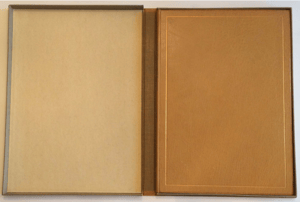If you are a book collector or a collector of rare ephemera, you already may know about clamshell boxes and their importance for preserving rare books and paper. In short, a clamshell box is a particular type of bespoke archival box that is made individually for a specific book or collection of papers.
To be clear, clamshell boxes open up just like books and are usually custom-made according to the specifications of a particular book or object. As such, no two customized clamshell boxes are necessarily alike. They’re also frequently decorated with handmade papers, making clamshell boxes protective tools as well as decorative items for a library shelf. Anyone who owns rare books should learn more about clamshell boxes and should consider having them custom-made for particularly rare volumes.
Custom-Made Clamshell Boxes for Rare Books and Papers

You’ve probably seen a clamshell box before even if you weren’t sure what to call it. It has a hinge of sorts on one of its three sides, allowing the book to lay flat inside the bottom (or tray) of the box while the top-side and spine-side can be opened and extended for viewing the book. The top and bottom fit into one another snugly to provide complete cover and protection for the book inside.
A clamshell box, first and foremost, is designed to protect your rare book while it is stored on your shelf. The Library of Congress emphasizes that proper storage of books includes keeping them relatively dry, minimizing exposure to any kind of light (but especially intense light), keeping them free from dust, and keeping them shelved upright or flat. A clamshell box allows you to perform all of these proper storage techniques and to keep your book safe for a very long time. As a bonus, many custom-made clamshell boxes, as we mentioned above, are designed with handmade acid-free papers that also allow clamshell boxes to serve a decorative purpose on your shelves.
One of the most important features of any clamshell box is that it is made from archival paper. Archival paper is acid-free and is typically free from any bleaches, brighteners, and pulp. Most archival papers are made with 100 percent cotton. It is also important for the clamshell box to be tailored to the size and shape of the book. When a clamshell box is custom-made like this, it can protect the book from damage and can house the book without risking the sides or corners getting bumped.
Buying Standard Archival Clamshell Boxes in a Pinch
We just finished telling you all about custom-made clamshell boxes that are created according to the precise size of a particular book. Yet not all clamshell boxes are tailored to fit a certain object. If you’re in a rush and want to protect a book or collection of papers until you can have a bespoke clamshell box made for the specific work, you can purchase standard archival clamshell boxes.
Standard archival clamshell boxes can come in a variety of sizes, typically designed to hold standard-sized books and papers. For example, you will be able to find standard clamshell boxes in sizes like 5x7, 8.5x11, and 11x14. Most of them have a standard depth of either 2 or 2.5 inches. Of course, standard archival clamshell boxes will not arrive with handmade papers or other decorative objects to adorn them. They’re typically black, white, or a shade of grey. Since books are safer in clamshell boxes that are tailored to their specific size to prevent movement inside while still giving the book just a tiny bit of breathing room, it is best to eventually have a custom-made clamshell box designed.
Making Your Own Clamshell Boxes

There are numerous archival services that can help you to purchase custom-made clamshell boxes for your rare books. If you are particularly enterprising, you might consider learning to make tailored clamshell boxes yourself. You’ll need a number of supplies to get started, including acid-free book board or chip board, acid-free paper to cover the clamshell box, a ruler, a large cutting board, a pencil, an exacto knife, polyvinyl acetate (or PVA) glue, a brush, a small cup of water, and a bone folder. Before you begin, it’s important to know that these boxes can be complicated to make, and you might not get it right on the first try. You can seek out instructions from a variety of sources online, or you might try to find a local class where you can learn from someone with experience making these archival boxes.
You might be lucky enough to live near a university or a local bindery that offers workshops for learning to make clamshell boxes. For example, one preservation library at Wake Forest University wrote about his experience learning to make clamshell boxes at Cat Tail Bindery in nearby Virginia.
Ultimately, a clamshell box can protect your rare book for years and even decades. If you don’t already have clamshell boxes for your rarest items, consider having them custom-made. And in the meantime, be sure to take precautions when it comes to exposing your books to light, dust, and wear on your shelves.









